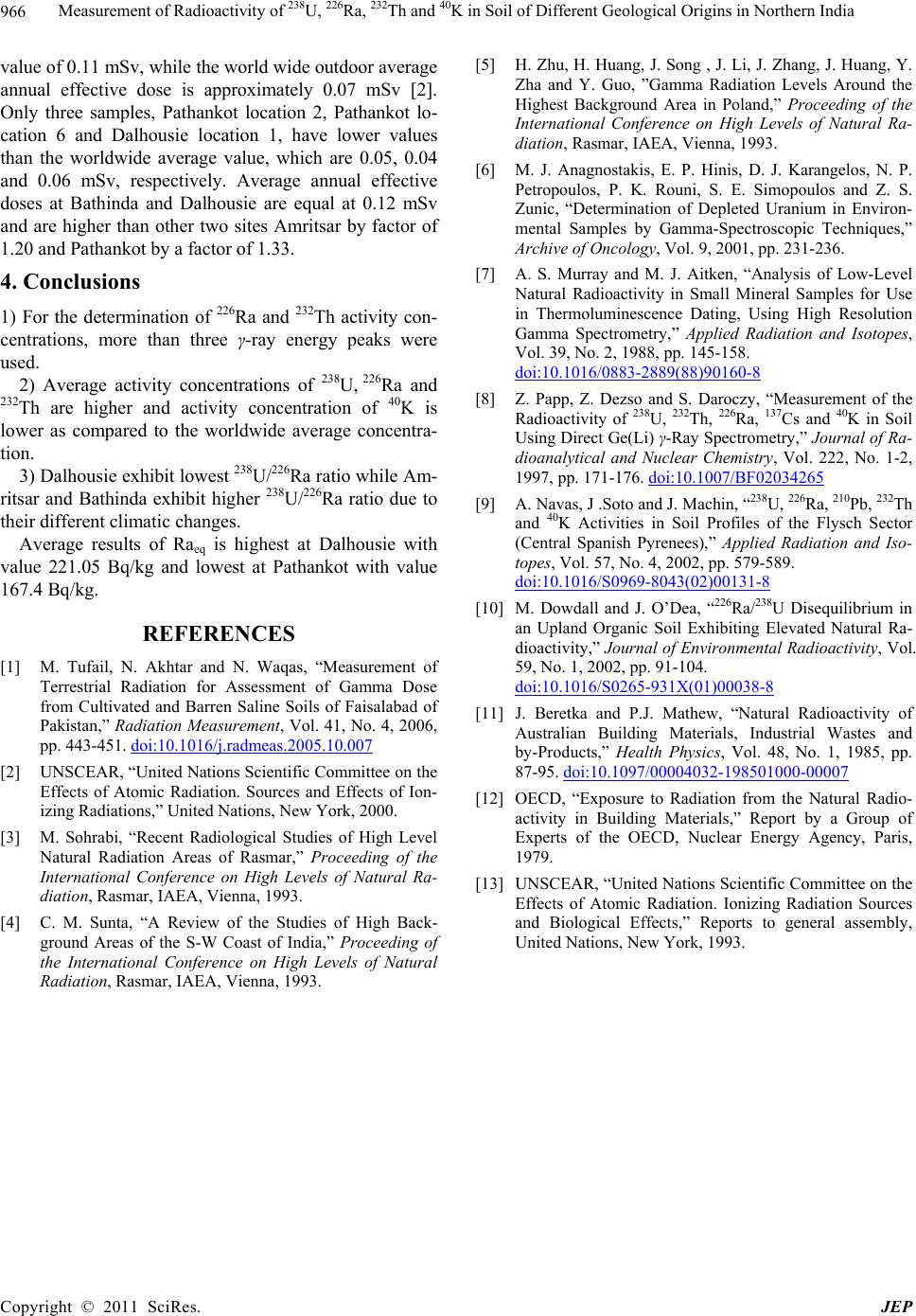
Measurement of Radioactivity of 238U, 226Ra, 232Th and 40K in Soil of Different Geological Origins in Northern India
966
value of 0.11 mSv, while the world wide outdoor average
annual effective dose is approximately 0.07 mSv [2].
Only three samples, Pathankot location 2, Pathankot lo-
cation 6 and Dalhousie location 1, have lower values
than the worldwide average value, which are 0.05, 0.04
and 0.06 mSv, respectively. Average annual effective
doses at Bathinda and Dalhousie are equal at 0.12 mSv
and are higher than other two sites Amritsar by factor of
1.20 and Pathankot by a factor of 1.33.
4. Conclusions
1) For the determination of 226Ra and 232Th activity con-
centrations, more than three γ-ray energy peaks were
used.
2) Average activity concentrations of 238U, 226Ra and
232Th are higher and activity concentration of 40K is
lower as compared to the worldwide average concentra-
tion.
3) Dalhousie exhibit lowest 238U/226Ra ratio while Am-
ritsar and Bathinda exhibit higher 238U/226Ra ratio due to
their different climatic changes.
Average results of Raeq is highest at Dalhousie with
value 221.05 Bq/kg and lowest at Pathankot with value
167.4 Bq/kg.
REFERENCES
[1] M. Tufail, N. Akhtar and N. Waqas, “Measurement of
Terrestrial Radiation for Assessment of Gamma Dose
from Cultivated and Barren Saline Soils of Faisalabad of
Pakistan,” Radiation Measurement, Vol. 41, No. 4, 2006,
pp. 443-451. doi:10.1016/j.radmeas.2005.10.007
[2] UNSCEAR, “United Nations Scientific Committee on the
Effects of Atomic Radiation. Sources and Effects of Ion-
izing Radiations,” United Nations, New York, 2000.
[3] M. Sohrabi, “Recent Radiological Studies of High Level
Natural Radiation Areas of Rasmar,” Proceeding of the
International Conference on High Levels of Natural Ra-
diation, Rasmar, IAEA, Vienna, 1993.
[4] C. M. Sunta, “A Review of the Studies of High Back-
ground Areas of the S-W Coast of India,” Proceeding of
the International Conference on High Levels of Natural
Radiation, Rasmar, IAEA, Vienna, 1993.
[5] H. Zhu, H. Huang, J. Song , J. Li, J. Zhang, J. Huang, Y.
Zha and Y. Guo, ”Gamma Radiation Levels Around the
Highest Background Area in Poland,” Proceeding of the
International Conference on High Levels of Natural Ra-
diation, Rasmar, IAEA, Vienna, 1993.
[6] M. J. Anagnostakis, E. P. Hinis, D. J. Karangelos, N. P.
Petropoulos, P. K. Rouni, S. E. Simopoulos and Z. S.
Zunic, “Determination of Depleted Uranium in Environ-
mental Samples by Gamma-Spectroscopic Techniques,”
Archive of Oncology, Vol. 9, 2001, pp. 231-236.
[7] A. S. Murray and M. J. Aitken, “Analysis of Low-Level
Natural Radioactivity in Small Mineral Samples for Use
in Thermoluminescence Dating, Using High Resolution
Gamma Spectrometry,” Applied Radiation and Isotopes,
Vol. 39, No. 2, 1988, pp. 145-158.
doi:10.1016/0883-2889(88)90160-8
[8] Z. Papp, Z. Dezso and S. Daroczy, “Measurement of the
Radioactivity of 238U, 232Th, 226Ra, 137Cs and 40K in Soil
Using Direct Ge(Li) γ-Ray Spectrometry,” Journal of Ra-
dioanalytical and Nuclear Chemistry, Vol. 222, No. 1-2,
1997, pp. 171-176. doi:10.1007/BF02034265
[9] A. Navas, J .Soto and J. Machin, “238U, 226Ra, 210Pb, 232Th
and 40K Activities in Soil Profiles of the Flysch Sector
(Central Spanish Pyrenees),” Applied Radiation and Iso-
topes, Vol. 57, No. 4, 2002, pp. 579-589.
doi:10.1016/S0969-8043(02)00131-8
[10] M. Dowdall and J. O’Dea, “226Ra/ 238U Disequilibrium in
an Upland Organic Soil Exhibiting Elevated Natural Ra-
dioactivity,” Journal of Environmental Radioactivity, Vol.
59, No. 1, 2002, pp. 91-104.
doi:10.1016/S0265-931X(01)00038-8
[11] J. Beretka and P.J. Mathew, “Natural Radioactivity of
Australian Building Materials, Industrial Wastes and
by-Products,” Health Physics, Vol. 48, No. 1, 1985, pp.
87-95. doi:10.1097/00004032-198501000-00007
[12] OECD, “Exposure to Radiation from the Natural Radio-
activity in Building Materials,” Report by a Group of
Experts of the OECD, Nuclear Energy Agency, Paris,
1979.
[13] UNSCEAR, “United Nations Scientific Committee on the
Effects of Atomic Radiation. Ionizing Radiation Sources
and Biological Effects,” Reports to general assembly,
United Nations, New York, 1993.
Copyright © 2011 SciRes. JEP